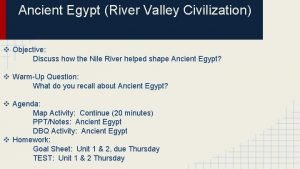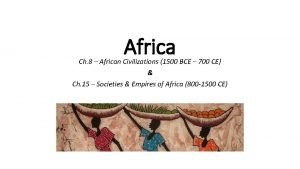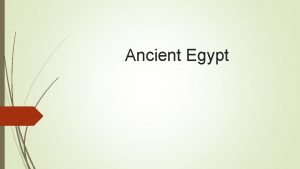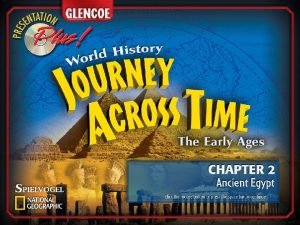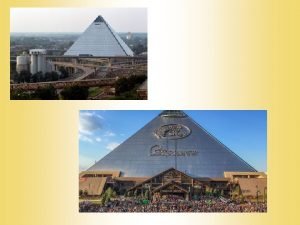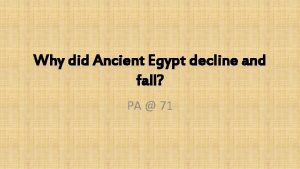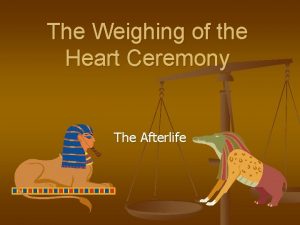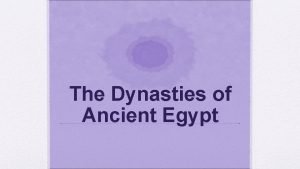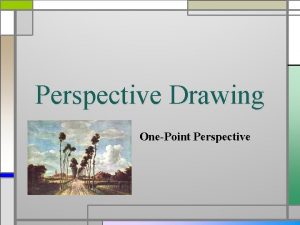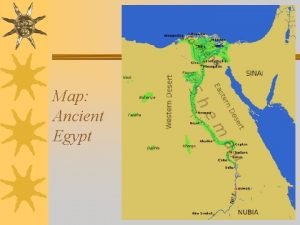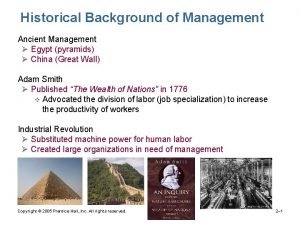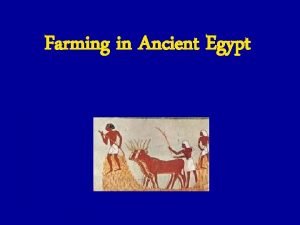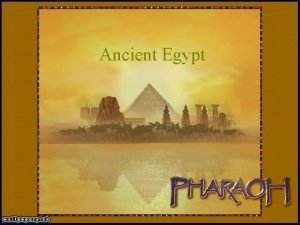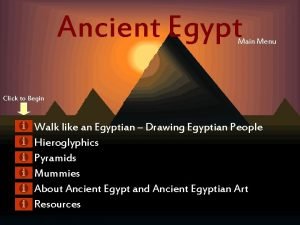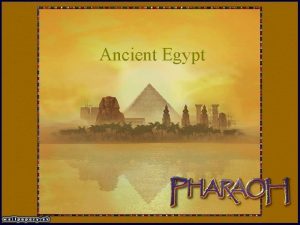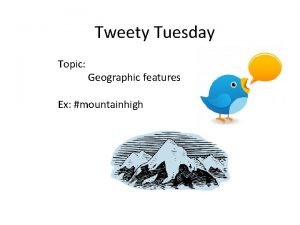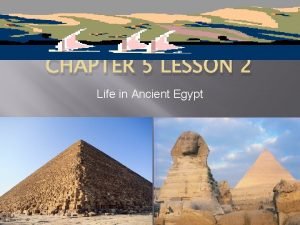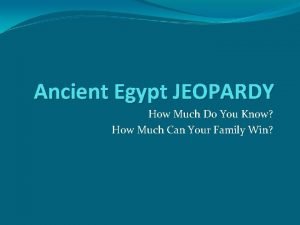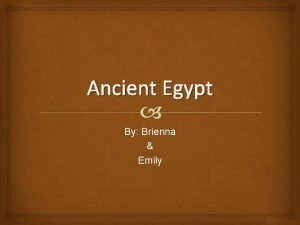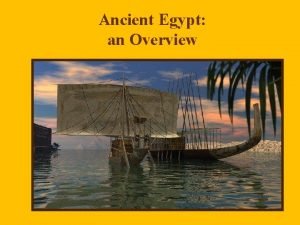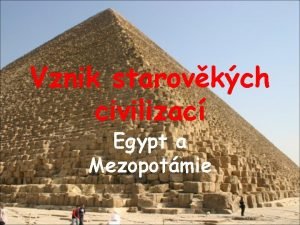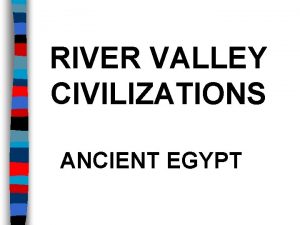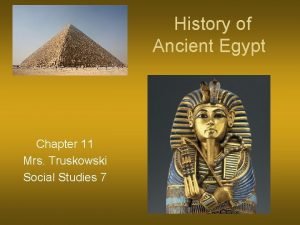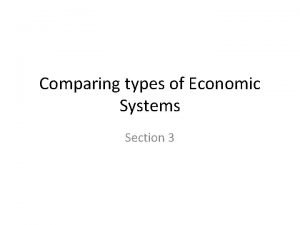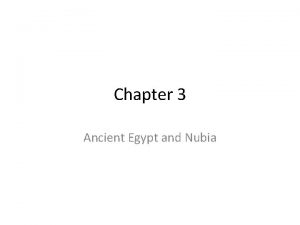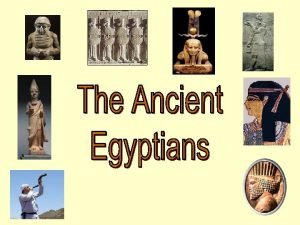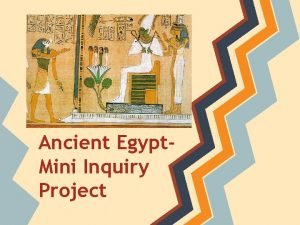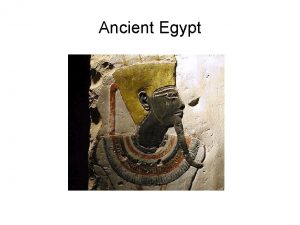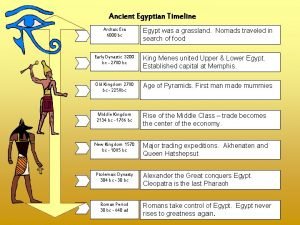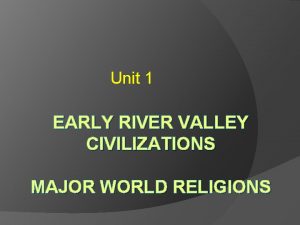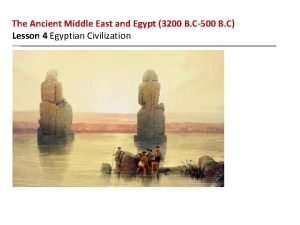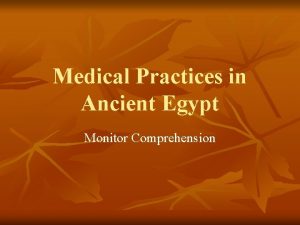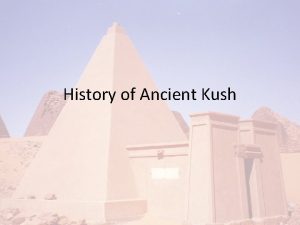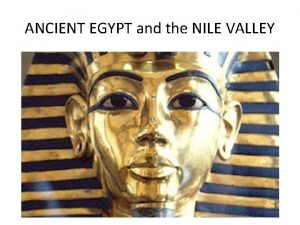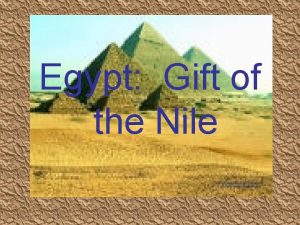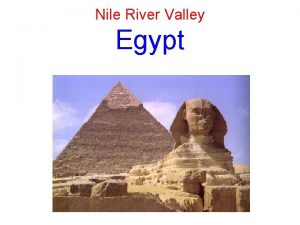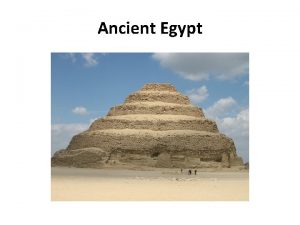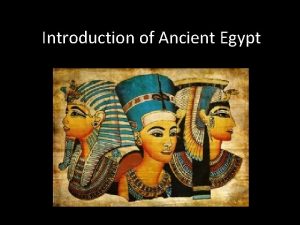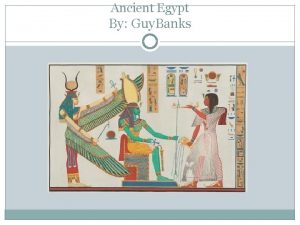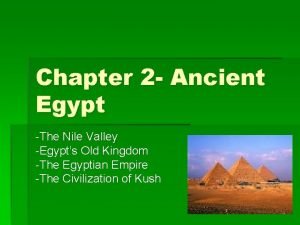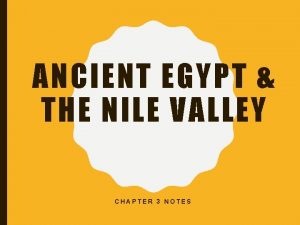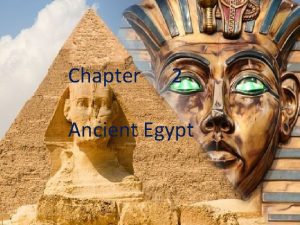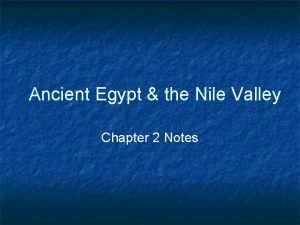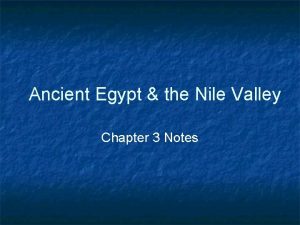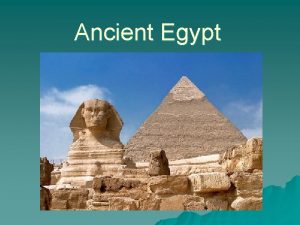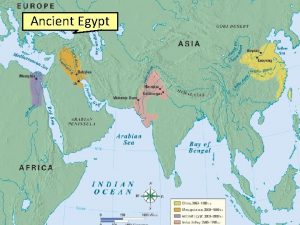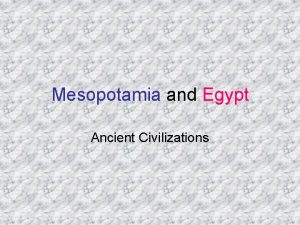Ancient Egypt Chapter 2 The Nile Valley Chapter


















































- Slides: 50

Ancient Egypt Chapter 2

The Nile Valley Chapter 2, Section 1

Hunter and gatherers settled in the Nile River Valley on the riverbanks, they are known as Egyptians.

What is weather like in Egypt?

Egypt warm, sunny, very little rain

The Nile River was crucial for life in Egypt- drinking water, bathing, farming, cooking, cleaning, fish, water for animals.

The Nile is the world’s longest river. *4, 000 miles long *runs North from the center of Africa and empties in the Mediterranean Sea. *Atlanta, GA to San Fransisco, CA

South of Egypt the Blue Nile and White Nile combine to create the Nile River.

What are cataracts?

Cataracts are narrow cliffs and boulders in the Nile that form rapids.

The Nile River is a narrow green valley that resembles a flower. The river empties into the Mediterranean Sea. What is a delta?

The Sahara Desert (the largest desert in the world) surrounds to the Nile River delta.

Sahara Desert was known as “the Red Land” to the ancient Egyptians, why?

What purpose did the Sahara Desert serve for the ancient Egyptians?

Protection from invaders. What other geographical features of the land protected the ancient Egyptians?

The rough cataracts of the Nile River blocked enemies from entering.

Egypt’s geographic features served as protection from invaders; however, the were able to trade in the Mediterranean Sea and develop into prosperous civilization.

The River People

River flooding was a major part of the Egyptian life.

The Nile River flooding was predictable and more gentle than the river flooding in Mesopotamia.

Egypt depended on the river flooding for farming.

Spring (July-October) brought about rains from Africa causing water to spill over the banks. What is Kemet?

Kemet is the dark, fertile mud left behind from flooding. The “Black Hand”

Egyptian farmers flourished and made excess food for themselves and animals.

Irrigation was used to trap floodwaters. Farmers dug trenches to carry waters.

Shadoofs were developed to assist farmers. They are still used today.

What else did the Egyptians develop?

*geometry for surveying after flooding *papyrus (? ) was used to make baskets, rafts, sandals, paper

What are hieroglyphics?

A writing system that is made up of thousands of picture symbols. Later, letters that stood for sounds were developed.

Who could read and write in ancient Egypt?

A United Egypt

The surplus of food from farming allowed some Egyptians to work as artisans (pottery, cloth, weapons, tools). This excess in goods brought about the ability to trade.

What brought about the need for government in Egypt?

With the rise is farming, crafting, and trade - the need for government came about in Egypt.

Government was created to settle land issues.

A few of the first government chiefs created small kingdoms. These kingdoms began to grow and become powerful.

Eventually Egypt was made of two kingdoms Lower Egypt (Nile delta area) and Upper Egypt (southern Egypt).

Narmer eventually united the two kingdoms - he took over control of Lower Egypt.

Narmer wore a double crown to show the unity of the two kingdoms.

What is a dynasty?

A line of rulers from one family. Narmer’s dynasty ruled long after his death.

Ancient Egypt: *31 dynasties *2, 800 years *Made of the Old Kingdom, Middle Kingdom, New Kingdom

Early Egyptian Life

Egypt’s Social Classes

Upper Class *nobles, priests, wealthy, government officials *lived in large estates, elegant homes with gardens and pools *servants *wore white linen clothes, heavy eye makeup, jewelry

Middle class*business men and goods producers *smaller homes *simple dress *produced linen cloth, jewelry, pottery, metal goods

Farmers *largest group *may rent land - pay with crops *worked for wealthy *lived along Nile, one room mud huts *diet of bread, beer, vegetables and fruit

Family Life: *father - head of the family *women could own property, buy/sell goods, make wills, obtain divorces *upper-class women could be involved in religious ceremonies

Children of Egypt: *most children did not go to school *girls taught by mothers to sew, cook, run household *boys learned farming and skills
 How did the nile shape ancient egypt
How did the nile shape ancient egypt How did the nile shape ancient egypt dbq answer key
How did the nile shape ancient egypt dbq answer key What lasting legacies did the aksum kingdom leave
What lasting legacies did the aksum kingdom leave Egypt is the gift of the nile
Egypt is the gift of the nile Janapriya nile valley
Janapriya nile valley Egypt advanced cities
Egypt advanced cities Guided reading activity 2-1 the nile valley answer key
Guided reading activity 2-1 the nile valley answer key Upper egypt and lower egypt
Upper egypt and lower egypt Northern greece
Northern greece Weighing of the heart ceremony ancient egypt
Weighing of the heart ceremony ancient egypt French rococo floral design
French rococo floral design Egypt vocabulary
Egypt vocabulary Egypt frontalism
Egypt frontalism British council ancient egypt
British council ancient egypt Specialized jobs in ancient egypt
Specialized jobs in ancient egypt Ancient egypt
Ancient egypt Ancient egypt map
Ancient egypt map What is historical background of management
What is historical background of management What crops did egypt grow
What crops did egypt grow Kalasiris egyptian clothing
Kalasiris egyptian clothing Ancient egypt transportation
Ancient egypt transportation Geographical map of ancient egypt
Geographical map of ancient egypt Egypt social pyramid
Egypt social pyramid What is frontalism
What is frontalism Egypt map
Egypt map Ancient egypt society
Ancient egypt society Pyramid of energy
Pyramid of energy Ancient egypt non chronological report
Ancient egypt non chronological report Egyptian social pyramid
Egyptian social pyramid Jeopardy ancient egypt
Jeopardy ancient egypt Ancient egypt basic needs
Ancient egypt basic needs The three kingdoms of ancient egypt
The three kingdoms of ancient egypt Kleopatra hrobka
Kleopatra hrobka Ancient egypt bell ringers
Ancient egypt bell ringers Specialized workers in egypt
Specialized workers in egypt Ancient egypt medicine
Ancient egypt medicine How old is ancient egypt
How old is ancient egypt Economy of ancient egypt
Economy of ancient egypt Map of ancient egypt and nubia
Map of ancient egypt and nubia Ancient egypt bell ringers
Ancient egypt bell ringers Egypt relative location
Egypt relative location Ancient egypt civilization geography
Ancient egypt civilization geography Economy of ancient egypt
Economy of ancient egypt Disadvantages of ancient egypt geography
Disadvantages of ancient egypt geography Pharaoh timeline
Pharaoh timeline Ancient egypt civilization
Ancient egypt civilization Egyptian hierarchy
Egyptian hierarchy Fun facts for greece
Fun facts for greece Medical practices in ancient egypt answer key
Medical practices in ancient egypt answer key Kush on a map
Kush on a map Ancient egypt slogans
Ancient egypt slogans

